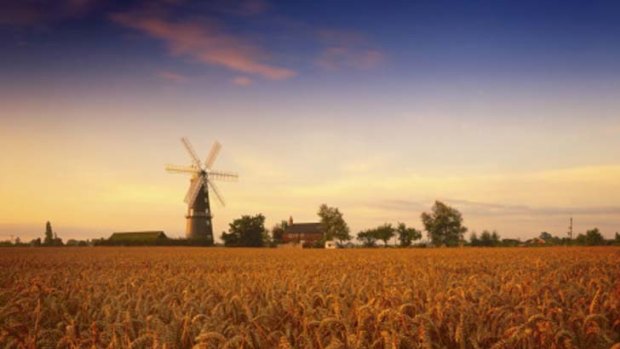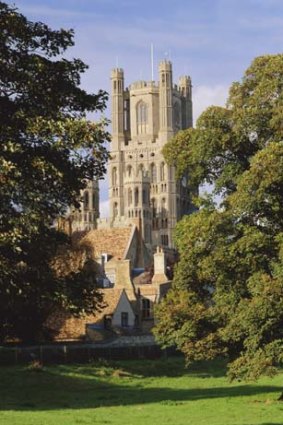
On the level ... the flat Fens landscape.Credit: Getty Images
Steve McKenna finds traces of Darwin, Cromwell and Geoffrey Rush, plus a pretty pocket-size town, in the country's damp and mysterious Fenland.
RISING incongruously from its flat surrounds, the "Ship of the Fens" sparks a mini-commotion when it comes into view. A group of elderly tourists press their noses - and steamed-up glasses - against the train window.
"Oooh, isn't that a funny-looking thing?" says one seventysomething.

Ely Cathedral.Credit: Getty Images
Used in the film The King's Speech, Elizabeth: The Golden Age and The Other Boleyn Girl, Ely's hypnotic, octagon-towered cathedral looms, like a giant vessel, over the Fens, the vast, low-lying, flood-prone plains of eastern England.
The cathedral was built in Norman times on a former Anglo-Saxon monastery and rose from what was formerly the Isle of Eels, named because the waters surrounding it were so infested with the slimy, snake-like fish that taxes were once paid with them.
Drainage projects mean Ely, as it's known now, is an island no more. Population 15,000, it's England's third-smallest city and is the most alluring settlement in Fenland, which spans about 2000 square kilometres, stretching north from Cambridge to Lincoln and east to the Wash, an inlet of the North Sea.
Both an agoraphobic's nightmare and a paradise for lovers of wide, open space, the Fens have long inspired ramblers, writers, artists and photographers, while Charles Darwin is known to have rummaged through the area for specimens while at Cambridge University.
I'm visiting Ely - an hour north of London - on a day trip from Cambridge, where the tourist- and student-packed streets were wearing me out.
My first stop is Ely's attractive waterfront. Ducks, barges and rowers navigate the River Ouse, whose banks are edged by pubs and restaurants that rustle up local delicacies such as eel pie, eel stew and smoked eel.
I take a spot in the leafy courtyard of Peacocks, an adorably quaint tearoom, which serves 72 teas from five continents. Soothed with Builders' English Tea, scones, clotted cream and strawberry jam, I stroll through Ely's winding streets, pausing to admire Georgian properties, antiques shops, bookstores and galleries with evocative Fenland paintings.
The peculiarly magnetic environment was used as the backdrop for Booker Prize-winning author Graham Swift's acclaimed 1983 novel, Waterland, a melancholic tale of murder, incest and kidnap, later made into a movie starring Jeremy Irons, Ethan Hawke and, in her debut role, Maggie Gyllenhaal. Swift, a Londoner, said the Fens left such a "haunting impression" when he first saw them that they became a "principal character" in his story.
His initial glimpse, like mine, came while on a train. During the short rail journey from Cambridge, it was as though we'd been transported to the Netherlands. There wasn't a hill in sight. Windmills twirled above pancake-flat fields gorged with canals. Flocks of coots and warblers took flight from peaty marshland.
The cathedral looked lofty from the train. Close up, it's magnificent, dominating the city centre. Boasting England's largest nave, as well as rows of majestic arches on either side, it doubled as Westminster Abbey for the scene in The King's Speech when Geoffrey Rush's character helps Colin Firth's king practise his coronation speech.
A vehement anti-royalist is the subject of Ely's best museum. Oliver Cromwell's House is the photogenic, half-timbered old home of this controversial "man of the Fens", a god-fearing farmer, tax collector and politician who led the parliamentarians to victory over the royalists in the English Civil War (1642-49).
Cromwell is often portrayed as a curmudgeonly, warty, regicidal warmonger - he oversaw the beheading of King Charles I, hated Christmas and rampaged through Scotland and Ireland - but the displays and exhibits in his old house, where he lived with his family, suggest he was more misunderstood than outright malicious. Perhaps.
Just as intriguing are Ely's sporadic public information points, which reflect on the wider Fenland area. The Dutch flavours I detected from the train are no coincidence.
Before the civil war, engineers from the Netherlands drained the Fens with what were then cutting-edge Dutch techniques.
Pockets of civilisation had lived on Fen islands since pre-Roman times, relying on fishing, fowling and scraps of farming to get by, but the fertile, yet frequently submerged, land wasn't living up to its vast agricultural potential. Nor was it a great place to raise sheep. At the time, eastern England had a thriving wool industry but the Fens had largely missed the boat.
Local opposition to the drainage changes was fierce and often violent. Cromwell was said to be among the dissidents (not necessarily because he objected to the idea, more that it was a scheme backed by the king). The narkiest of labourers apparently sneaked back at night to fill in the ditches they'd been forced to dig during the day.
It wasn't until the 1820s, after the introduction of wind, then steam, pumps that the Fens were widely drained, creating 100,000-plus additional hectares of arable land.
One sign points out, however: "Draining the Fens has taken man two thousand years, but the challenges involved in keeping them dry - of peat shrinkage, siltation, tidal surges and sea level change - are as real as ever."
Environmentalists fear that by 2030, this constantly evolving landscape could be lost to the sea again. Although 2011 is the driest year for some time, Ely may once again become the Isle of Eels.
I have an insatiable urge to delve further into the Fenland wilderness described by Swift, in Waterland, as "a landscape that of all landscapes, most approximates to Nothing".
But my plan is thwarted when the heavens open. I dash away from the fields and back to the station. I vow to come back another time - better prepared. The Fens, I reason, are no place to tread without wellies.
Trip notes
Getting there
Trains for Ely leave Cambridge four times an hour; 15-minute journey £4 ($6) return. Ely is a one-hour ride from London Kings Cross (£25.50 return). firstcapitalconnect.co.uk.
Staying there
In Ely, the Lamb Hotel is a restored 15th-century coaching inn; B&B doubles priced from £90, oldenglishinns.co.uk/ely.
More information
Three other places to visit in Fenland
1 Wicken Fen This National Trust-run nature reserve, between Cambridge and Ely, is home to toads, frogs, lizards and 1500 types of beetle; Darwin would love it here, wicken.org.uk.
2 Flag Fen One of Britain's most important Bronze Age settlements, it's the site of a 3500-year-old ritual causeway and ceremonial platform. Made from wood, it contains 60,000 upright timbers and has a collection of Bronze Age Celtic swords, jewellery and tools, flagfen.com.
3 Fenscape Discovery Centre Using interactive and audio-visual displays, this is the definitive place to learn about the past, present and (projected) future of the Fens, www.fenscape.org.
Sign up for the Traveller Deals newsletter
Get exclusive travel deals delivered straight to your inbox. Sign up now.